

I had just concluded my first war against the Americans (and the English, not that I ever even so much as saw one of their units) and was now prepared to hunker down and rebuild for the next twenty turns. By the rules of this game, I HAD to adhere to the peace treaty even if I didn't want to, so it was definitely time for some peaceful reconstruction. I switched Salamanca over to settler production, giving it back the grasslands wheat that Niagra Falls had been working, and switched the latter city to spear production. One of the keys to my success in this game was constantly micromanaging the tiles that my core cities worked; this was pretty easy to do since I only had four of them to worry about. Everything else was a secondary, corrupt colony. Salamanca and Niagra passed the wheat tile back and forth too many times even to count, always to get the maximum benefit from it. One would produce units while the other produced workers/settlers, almost entirely throughout the game. The close attention to detail really paid off though, and I enjoyed much higher productivity and less waste than the AI civs.
Top priority for this interval of peace was to secure a safe road all the way to America; not to trade like I might in other games, but so that I could deliver archers quickly and effectively to the front in the next war. Roads could only be safe by building cities along the way, little "inns" where my units could end their turns safely and not have to worry about barbs pillaging the vital lifeline that the roads formed. That meant that I needed more settlers, but even more importantly workers to form the roadbuilding crews. I had just about finished improving the tiles around my cities by this point (none were ever getting over size 6, after all) and so my workers went out into the world to build the first of the great roads that would span my continent. This one traced south along the continent, running through the two cities that I founded down there to replaced the auto-razed American ones and terminating (eventually) outside Washington. By 1500AD, I had founded all three cities that I needed to form this chain and had nearly completed the road; here a picture showing part of that process:
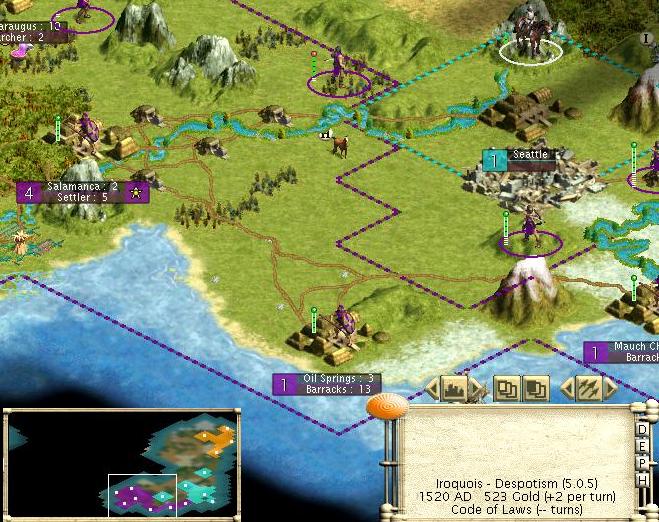
Looking at the minimap, you can see how my cities stretch in a line right up to the American capital. The road you see in the picture is the Great Southern Road that would lead into the American heatland in the next war. Also note that the Americans have refounded Seattle right in the middle of my land where Boston used to be; the stupid thing would have to be razed immediately in the next war. As soon as I completed the southern road, I began building one in the north as well where no cities were located at this time. What you can't really see from this pictures is just how unconnected everything was in this game; the American cities lacked roads between them and there was an enormous undeveloped region between America and England with no fast way to cross the distance. With the clock a major obstacle in this game, sending workers along with archers to build roads and create supply lines was extremely important. Players who did not do this probably will not enjoy the same degree of success that I did.
In 1620AD, Abe founded an embassy with me. Very nice, but not the best timing; there was one turn left on our peace treaty at the time, ha. I declared war again as soon as I was permitted by the rules, which in this case fell to the date 1640AD. Yes, that's right: from 1080AD to 1640AD was only 20 turns (!) Time was running out before the mandatory retirement date at 2000AD, and I wanted to hopefully clear my starting continent of both opponents by that date, though at the moment that was looking unlikely. Still, no time to stop and dwell on the negatives - I had a war to fight! It took a turn to position my 1-move archers into range, but in 1660AD I was able to capture (and auto-raze, again) both the city of Seattle and a recently founded San Francisco. Woohoo - four more scenario points!
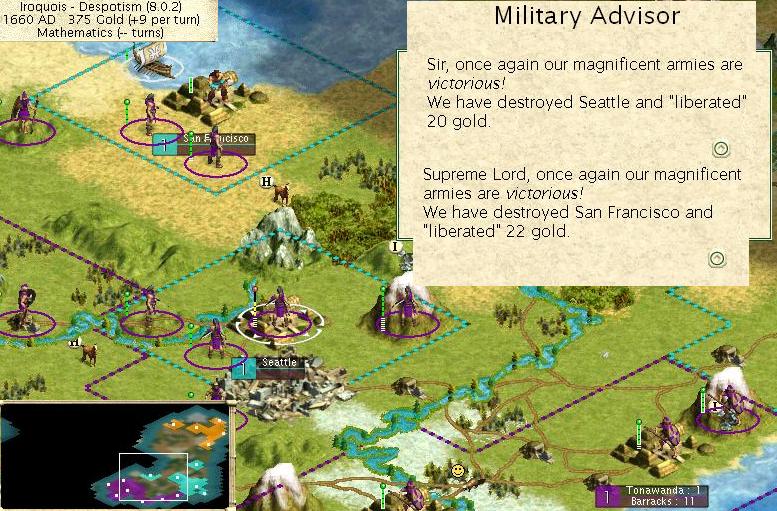
If the picture looks a little strange, it's because I pieced it together from two different ones showing each town being captured separately. But hey, no reason to show two pictures when one will do. Since I was planning nothing but extermination for America, there was no reason not to bring a friendly Liz into it as well. She was more than willing to jump into the fight for a measly 70g; not that I expected any help from Liz, but at least England would not ally against me.
Even with my roads, it took a number of turns to reach Washington. It was pretty lightly defended, only three or four spears, and that doesn't present much of an obstacle at all when you bring over 15 archers to the party. The American capital fell in 1740AD:
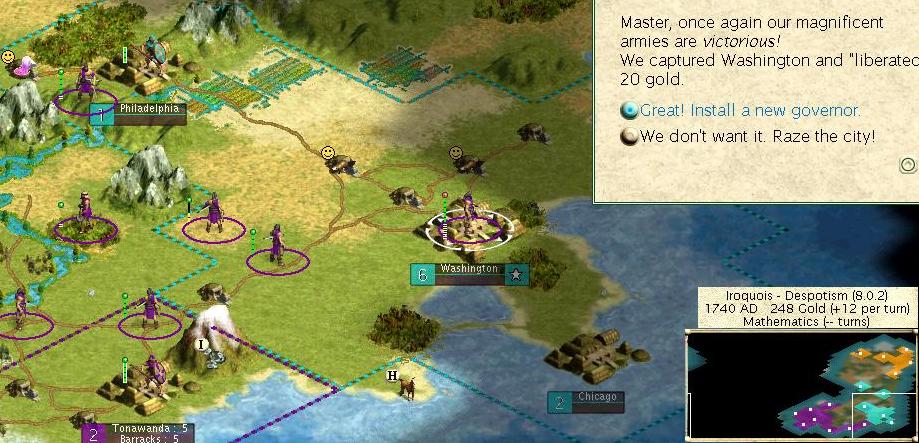
With the American capital out of the way, the other nearby cities fell quite quickly. The capital jumped up to the corrupt northeast town of Atlanta; I have no idea why it didn't go to a larger or older city. Chicago was captured - and autorazed - in 1770AD. Philadelphia was captured - and autorazed too, dang it! - in 1780AD. I have pictures of capturing these cities (and every other one I took in the game) in case someone wants to dispute my results in the scoring, but to keep this report fairly brief I won't post all of them unless the need arises. With the fall of Phillie, the Americans were down to just two cities in the no man's land between me in the south and England in the north. I continued sending forces up there to take those last refuges away and continued building roads as well in the wake of my units.
Meanwhile, I finally built a galley and contacted the other civs in 1810AD. The Aztecs and the Spanish were on the other island, and I immediately established embassies with both of them (if there's one thing despotism lacks, it isn't cash funds). To my pleasant surprise, they were at war with one another and no further along in tech than my continent. That was great; my nightmare was conquering my continent to find muskets on the other one. Now I would have at least a chance to make some gains there as well, provided I wiped out the Americans and English first. That had to come first.
Atlanta was captured from the Americans in 1820AD, and all of a sudden they were down to just one city remaining. I popped a goody hut on the western island on the next turn and got Literature for free, not that it made a difference now. Rather than trade it to the other civs on the other island, I held on to it to try and slow down the tech race as much as possible. After taking Atlanta, it was just a matter of shuffling over to Miami and ending Abe's miserable presence from the planet. Chalk up 20 bonus points for me:
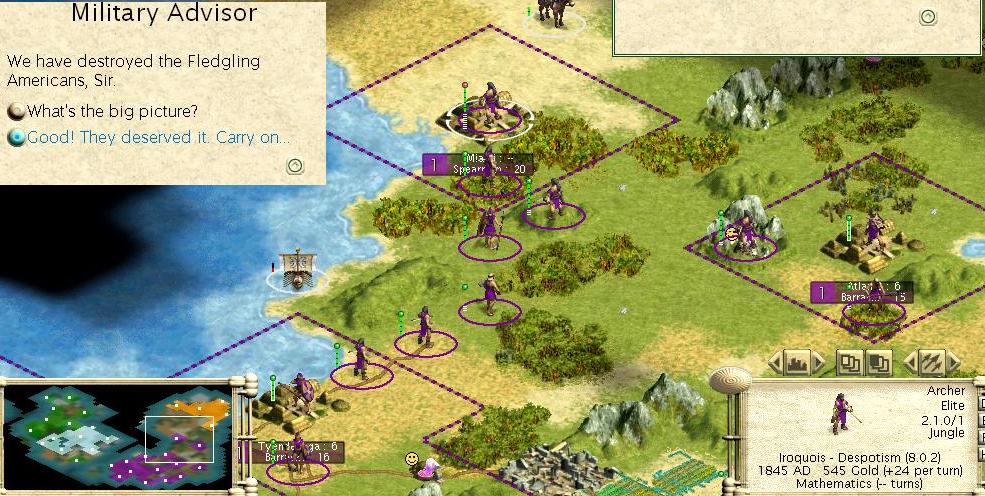
That shot shows the progress I had made on my continent and reveals the other one for the first time. You can see both of the last two American cities, Atlanta and Miami, as well. I also like this shot because it shows my workers, the brave little "combat engineers" as well, hard at work paving the road to the next conquered city. And it also shows more archers coming up from the west towards the front, sped along by the series of towns founded in my wake. Now it was time to head up to England, which had been stunted by a genuine Epic14 dud start. This was an Emperor game, but you wouldn't have known it from the pitifully slow growth that Elizabeth turned out. It was 1850AD and my archers could only approach England by moving one tile per turn, a painfully slow rate until the roads pushed up to the front, but I estimated that I would have enough time to kill off Liz before 2000AD hit. Well in any case, here goes nothing.
I reached the borders of England in 1870AD and declared war on the following turn. York, England's second strongest city, was foolishly working on the Great Lighthouse at the time of my attack. I knew from using my embassy to spy before declaring war that it only had one spear for defense, and that London had only two spears itself. London was working on the Pyramids at the time too... :weed: I didn't exactly expect England to pose much of a challenge, in other words. The one and only spear at York went nuts though, killing no fewer than FOUR archers and going to elite before I finally killed it. The unit even produced a great leader (!) which was foolishly left exposed in the open to the north of the city, where I captured and killed it on the same turn using York's roads. I love killing enemy leaders, ha. Here's the screenshot:

Notice too the road coming up from the south to link up with the English roads. With so much of a focus on roads, I felt like I should have been Rome in this game, heh. They were worth the importance that I put on them in this report though; without them, I never could have gotten as far as I did. I also founded the city of Caughnawaga "overseas" on the western island on this turn in 1880AD; it was never captured or even threatened in any way. That locked down what was probably the easiest bonus points for this game, but I wasn't going to pass them up in any case.
I took Canterbury next, the English city all the way out in the west by itself. There were no roads of any kind out there, so it was a good thing that I had sent a separate attack force there. That city was auto-razed when I captured it, and it was never rebuilt. That land was abandoned to the barbarians. If you haven't guessed by now, I simply did not have the time to cover the whole starting continent in my cultural borders. With no temples anywhere and lots of open land, it just wasn't going to happen before 2000AD. And since I wasn't going to go for that bonus, I decided I would avoid ever using the despotic whip, which I estimated I could not use to enough of an advantage to justify losing the 10 scenario points. My math might have been wrong or it may not have been, but in any case I never cracked the whip at all in this game.
London was the next city in line after York, and my forces reached the city in 1910AD. It was still defended by no more than two (regular) spears and still was trying to complete the Pyramids. Yeah, nice try Liz. The lack of roads between English cities prevented any reinforcements from reaching London in time to make a difference, and the capital fell on the first attempt to take it:
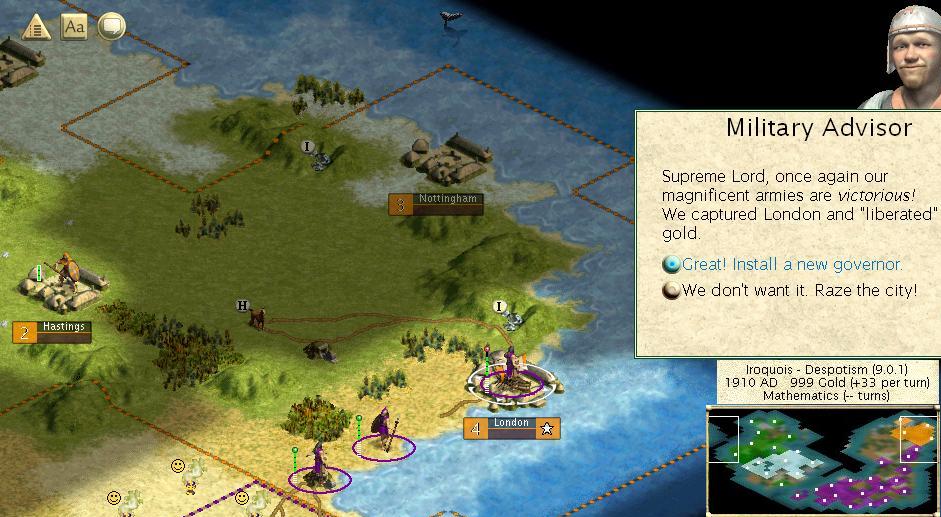
The lack of tile improvements around the English cities wasn't due to my pillaging; the English had simply been pathetically slow in developing their civ. It was almost sad to see, but it demonstrates two major points; first, that with a bad starting position even the Emperor AI civs don't do very well, and second that the AI civs are not programmed to deal well with the corruption on tiny maps. Things like locking two of England's only productive cities onto wonders were decisions beyond foolish for the scope of this game. Ah well, there's always next time Liz.
There was nothing left to oppose me, so I just rolled through the remaining English cities. Hastings was taken in 1925AD, Nottingham in 1935AD, and the final city of Coventry in 1950AD. Remarkably, all of these cities were NOT auto-razed, making my job a lot easier. With only a few turns left, I now turned to seeing just how many cities I could take on the other continent before the deadline approached. I leave you with Elizabeth's death shot:
This image has been lost.






